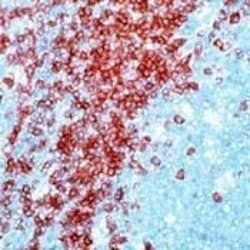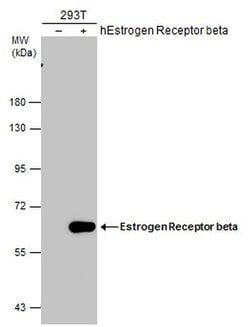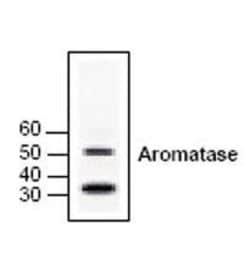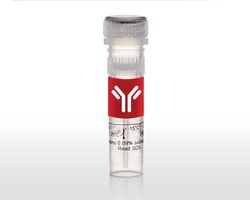01-950-111
Influenza A H1N1 HA Monoclonal Antibody (C102), Invitrogen™
Manufacturer: Thermo Scientific
Select a Size
| Pack Size | SKU | Availability | Price |
|---|---|---|---|
| Each of 1 | 01-950-111-Each-of-1 | In Stock | ₹ 50,151.50 |
01-950-111 - Each of 1
In Stock
Quantity
1
Base Price: ₹ 50,151.50
GST (18%): ₹ 9,027.27
Total Price: ₹ 59,178.77
Antigen
Influenza A H1N1 HA
Classification
Monoclonal
Concentration
5.5 mg/mL
Formulation
PBS with 0.09% sodium azide; pH 7.4
Host Species
Mouse
Purification Method
Protein G
Regulatory Status
RUO
Target Species
Virus
Product Type
Antibody
Isotype
IgG1
Applications
ELISA, Hemagglutination Assay, Immunocytochemistry, Immunohistochemistry, Inhibition Assays, Western Blot
Clone
C102
Conjugate
Unconjugated
Gene Alias
flu hemagglutinin; H1N1 HA; H1N1 hemagglutinin; Influenza H1N1; influenza hemagglutinin
Immunogen
Purified influenza virus type A strain H1N1.
Quantity
100 μg
Primary or Secondary
Primary
Content And Storage
4° C, do not freeze
Form
Liquid
Description
- Positive on strains: A/Beijing/262/95; A/New Caledonia/20/99; A/Taiwan/1/86; A/Texas/1/77
- Negative on strains: A/Leningrad/325/88; A/Panama/2007/99; A/Shangdong/9/93; B/Leningrad/86/ Influenza A virus is a major public health threat, killing more than 30,000 people per year in the USA
- In early 2009, a novel swine-origin influenza A (H1N1) virus was identified in specimens obtained from patients in Mexico and the United States
- The virus spread quickly around the world and on June 11, 2009, the World Health Organization declared it a pandemic
- Influenza A virus has one of sixteen possible Hemagglutinin (HA) surface proteins and one of nine possible Neuraminidase (NA) surface proteins
- The Hemagglutinin protein facilitates viral attachment while Neuraminidase is involved in viral release
- These proteins also elicit immune responses that prevent infection or independently reduce viral replication
- The genetic make-up of this swine flu virus is unlike any other: it is an H1N1 strain that combines a triple assortment first identified in 1998 including human, swine, and avian influenza with two new pig H3N2 virus genes from Eurasia, themselves of recent human origin
- The distinct antigenic properties of the new swine influenza virus compared with seasonal influenza A (H1N1) virus suggest that human immunity against new swine influenza virus is limited, although the age distribution of reported cases suggests some degree of protection in older age groups.
Compare Similar Items
Show Difference
Antigen: Influenza A H1N1 HA
Classification: Monoclonal
Concentration: 5.5 mg/mL
Formulation: PBS with 0.09% sodium azide; pH 7.4
Host Species: Mouse
Purification Method: Protein G
Regulatory Status: RUO
Target Species: Virus
Product Type: Antibody
Isotype: IgG1
Applications: ELISA, Hemagglutination Assay, Immunocytochemistry, Immunohistochemistry, Inhibition Assays, Western Blot
Clone: C102
Conjugate: Unconjugated
Gene Alias: flu hemagglutinin; H1N1 HA; H1N1 hemagglutinin; Influenza H1N1; influenza hemagglutinin
Immunogen: Purified influenza virus type A strain H1N1.
Quantity: 100 μg
Primary or Secondary: Primary
Content And Storage: 4° C, do not freeze
Form: Liquid
Antigen:
Influenza A H1N1 HA
Classification:
Monoclonal
Concentration:
5.5 mg/mL
Formulation:
PBS with 0.09% sodium azide; pH 7.4
Host Species:
Mouse
Purification Method:
Protein G
Regulatory Status:
RUO
Target Species:
Virus
Product Type:
Antibody
Isotype:
IgG1
Applications:
ELISA, Hemagglutination Assay, Immunocytochemistry, Immunohistochemistry, Inhibition Assays, Western Blot
Clone:
C102
Conjugate:
Unconjugated
Gene Alias:
flu hemagglutinin; H1N1 HA; H1N1 hemagglutinin; Influenza H1N1; influenza hemagglutinin
Immunogen:
Purified influenza virus type A strain H1N1.
Quantity:
100 μg
Primary or Secondary:
Primary
Content And Storage:
4° C, do not freeze
Form:
Liquid
Antigen: Estrogen Receptor beta
Classification: Monoclonal
Concentration: 1.23 mg/mL
Formulation: PBS with no preservative
Host Species: Mouse
Purification Method: Protein G
Regulatory Status: RUO
Target Species: Human, Mouse, Non-human Primate
Product Type: Antibody
Isotype: IgG2b
Applications: ChIP Assay, Dot Blot, Flow Cytometry, Immunocytochemistry, Immunohistochemistry (Paraffin), Western Blot
Clone: 14C8
Conjugate: Unconjugated
Gene Alias: ER; ER beta; ER[b]; Erb; Erb2; Erbeta; ER-beta; Esr2; ESRB; ESR-BETA; ESTRB; estrogen receptor 2; estrogen receptor 2 (beta); estrogen receptor 2 (ER beta); estrogen receptor 2 beta; estrogen receptor beta; estrogen receptor beta 1 isoform deletion variant; estrogen receptor beta 4; NR3A2; Nuclear receptor subfamily 3 group A member 2; oestrogen receptor beta; steroid receptor
Immunogen: Recombinant protein corresponding to residues 1-153 of human ER beta, expressed in E. coli.
Quantity: 100 μL
Primary or Secondary: Primary
Content And Storage: Store at 4°C short term. For long term storage, store at -20°C, avoiding freeze/thaw cycles.
Form: Liquid
Antigen:
Estrogen Receptor beta
Classification:
Monoclonal
Concentration:
1.23 mg/mL
Formulation:
PBS with no preservative
Host Species:
Mouse
Purification Method:
Protein G
Regulatory Status:
RUO
Target Species:
Human, Mouse, Non-human Primate
Product Type:
Antibody
Isotype:
IgG2b
Applications:
ChIP Assay, Dot Blot, Flow Cytometry, Immunocytochemistry, Immunohistochemistry (Paraffin), Western Blot
Clone:
14C8
Conjugate:
Unconjugated
Gene Alias:
ER; ER beta; ER[b]; Erb; Erb2; Erbeta; ER-beta; Esr2; ESRB; ESR-BETA; ESTRB; estrogen receptor 2; estrogen receptor 2 (beta); estrogen receptor 2 (ER beta); estrogen receptor 2 beta; estrogen receptor beta; estrogen receptor beta 1 isoform deletion variant; estrogen receptor beta 4; NR3A2; Nuclear receptor subfamily 3 group A member 2; oestrogen receptor beta; steroid receptor
Immunogen:
Recombinant protein corresponding to residues 1-153 of human ER beta, expressed in E. coli.
Quantity:
100 μL
Primary or Secondary:
Primary
Content And Storage:
Store at 4°C short term. For long term storage, store at -20°C, avoiding freeze/thaw cycles.
Form:
Liquid
Antigen: Aromatase
Classification: Polyclonal
Concentration: 0.5 mg/mL
Formulation: PBS with 0.5% BSA, 30% glycerol, 5mM EDTA and 0.03% ProClin 300; pH 7.2
Host Species: Rabbit
Purification Method: Antigen affinity chromatography
Regulatory Status: RUO
Target Species: Bovine, Chicken, Equine, Human, Mouse, Porcine, Rabbit, Rat
Product Type: Antibody
Isotype: IgG
Applications: Immunohistochemistry (Paraffin), Western Blot
Clone: __
Conjugate: Unconjugated
Gene Alias: Ar; ArKO; ARO; ARO1; Arom; Aromatase; aromatase 1; aromatase cytochrome P450; aromatase cytochrome P450 19A1; CPV1; CYAR; Cyp19; Cyp19a; Cyp19a1; CYP19P1; CYPXIX; CYPXIXA1; Cytochrome P450 17-alpha; cytochrome P450 19 type I; Cytochrome P450 19A1; cytochrome P450 aromatase; cytochrome P-450 aromatase; cytochrome P-450 aromatase (alt.); cytochrome P450 family 19 subfamily a; cytochrome P450 family 19 subfamily A member 1; Cytochrome P450, 19, aromatase; cytochrome P450, family 17, subfamily A, polypeptide 1; cytochrome P450, family 19, subfamily A, polypeptide 1; cytochrome P450, family XIX (conversion of androgen to estrogen), aromatase; cytochrome P450, family19, subfamily A, polypeptide 1; cytochrome P450, subfamily 19; cytochrome P450, subfamily XIX (aromatization of androgens); cytochrome P-450AROM; estrogen synthase; estrogen synthetase; flavoprotein-linked monooxygenase; Int5; Int-5; MGC104309; microsomal monooxygenase; P450AROM; P-450AROM; type III cytochrome p450 aromatase
Immunogen: Synthetic peptide surrounding amino acid 385 of human Aromatase
Quantity: 50 μg
Primary or Secondary: Primary
Content And Storage: Store at 4°C short term. For long term storage, store at -20°C, avoiding freeze/thaw cycles.
Form: Liquid
Antigen:
Aromatase
Classification:
Polyclonal
Concentration:
0.5 mg/mL
Formulation:
PBS with 0.5% BSA, 30% glycerol, 5mM EDTA and 0.03% ProClin 300; pH 7.2
Host Species:
Rabbit
Purification Method:
Antigen affinity chromatography
Regulatory Status:
RUO
Target Species:
Bovine, Chicken, Equine, Human, Mouse, Porcine, Rabbit, Rat
Product Type:
Antibody
Isotype:
IgG
Applications:
Immunohistochemistry (Paraffin), Western Blot
Clone:
__
Conjugate:
Unconjugated
Gene Alias:
Ar; ArKO; ARO; ARO1; Arom; Aromatase; aromatase 1; aromatase cytochrome P450; aromatase cytochrome P450 19A1; CPV1; CYAR; Cyp19; Cyp19a; Cyp19a1; CYP19P1; CYPXIX; CYPXIXA1; Cytochrome P450 17-alpha; cytochrome P450 19 type I; Cytochrome P450 19A1; cytochrome P450 aromatase; cytochrome P-450 aromatase; cytochrome P-450 aromatase (alt.); cytochrome P450 family 19 subfamily a; cytochrome P450 family 19 subfamily A member 1; Cytochrome P450, 19, aromatase; cytochrome P450, family 17, subfamily A, polypeptide 1; cytochrome P450, family 19, subfamily A, polypeptide 1; cytochrome P450, family XIX (conversion of androgen to estrogen), aromatase; cytochrome P450, family19, subfamily A, polypeptide 1; cytochrome P450, subfamily 19; cytochrome P450, subfamily XIX (aromatization of androgens); cytochrome P-450AROM; estrogen synthase; estrogen synthetase; flavoprotein-linked monooxygenase; Int5; Int-5; MGC104309; microsomal monooxygenase; P450AROM; P-450AROM; type III cytochrome p450 aromatase
Immunogen:
Synthetic peptide surrounding amino acid 385 of human Aromatase
Quantity:
50 μg
Primary or Secondary:
Primary
Content And Storage:
Store at 4°C short term. For long term storage, store at -20°C, avoiding freeze/thaw cycles.
Form:
Liquid
Antigen: VEGF
Classification: Polyclonal
Concentration: 0.2 mg/mL
Formulation: 10mM PBS with 0.2% BSA and 0.09% sodium azide; pH 7.4
Host Species: Rabbit
Purification Method: Protein A
Regulatory Status: RUO
Target Species: Human, Mouse, Rat
Product Type: Antibody
Isotype: IgG
Applications: Immunohistochemistry (Paraffin)
Clone: __
Conjugate: Unconjugated
Gene Alias: angiogenic factor; etID309976.16; eVEGF120; eVEGF164; human VEGF121 homolog; MGC70609; MVCD1; ovine vascular endothelial growth factor; RP1-261G23.1; unnamed protein product; VAS; vascular endothelial growth factor; vascular endothelial growth factor (VEGF) precursor; vascular endothelial growth factor 121 isoform; vascular endothelial growth factor 164; vascular endothelial growth factor 165b; vascular endothelial growth factor 182; vascular endothelial growth factor 182 isoform; vascular endothelial growth factor 188; vascular endothelial growth factor 188 isoform; vascular endothelial growth factor 189; vascular endothelial growth factor A; vascular endothelial growth factor A121; vascular endothelial growth factor A165; vascular endothelial growth factor Aa; Vascular endothelial growth factor A-A; vascular endothelial growth factor isoform 165; vascular permeability factor; Vasculotropin; VEGF; VEGF1; VEGF164; VEGF182; VEGF188; vegfa; VEGF-A; VEGFA165b; vegfaa; VEGF-A-A; VEGFMGC70609; VPF; VPF ant; wu:fj82c06
Immunogen: Human recombinant VEGF 165.
Quantity: 500 μL
Primary or Secondary: Primary
Content And Storage: 4° C, do not freeze
Form: Liquid
Antigen:
VEGF
Classification:
Polyclonal
Concentration:
0.2 mg/mL
Formulation:
10mM PBS with 0.2% BSA and 0.09% sodium azide; pH 7.4
Host Species:
Rabbit
Purification Method:
Protein A
Regulatory Status:
RUO
Target Species:
Human, Mouse, Rat
Product Type:
Antibody
Isotype:
IgG
Applications:
Immunohistochemistry (Paraffin)
Clone:
__
Conjugate:
Unconjugated
Gene Alias:
angiogenic factor; etID309976.16; eVEGF120; eVEGF164; human VEGF121 homolog; MGC70609; MVCD1; ovine vascular endothelial growth factor; RP1-261G23.1; unnamed protein product; VAS; vascular endothelial growth factor; vascular endothelial growth factor (VEGF) precursor; vascular endothelial growth factor 121 isoform; vascular endothelial growth factor 164; vascular endothelial growth factor 165b; vascular endothelial growth factor 182; vascular endothelial growth factor 182 isoform; vascular endothelial growth factor 188; vascular endothelial growth factor 188 isoform; vascular endothelial growth factor 189; vascular endothelial growth factor A; vascular endothelial growth factor A121; vascular endothelial growth factor A165; vascular endothelial growth factor Aa; Vascular endothelial growth factor A-A; vascular endothelial growth factor isoform 165; vascular permeability factor; Vasculotropin; VEGF; VEGF1; VEGF164; VEGF182; VEGF188; vegfa; VEGF-A; VEGFA165b; vegfaa; VEGF-A-A; VEGFMGC70609; VPF; VPF ant; wu:fj82c06
Immunogen:
Human recombinant VEGF 165.
Quantity:
500 μL
Primary or Secondary:
Primary
Content And Storage:
4° C, do not freeze
Form:
Liquid



